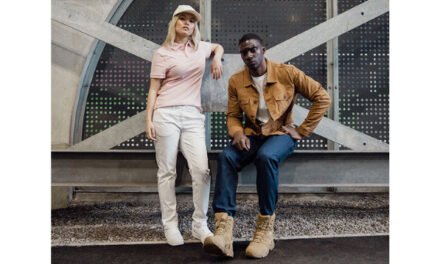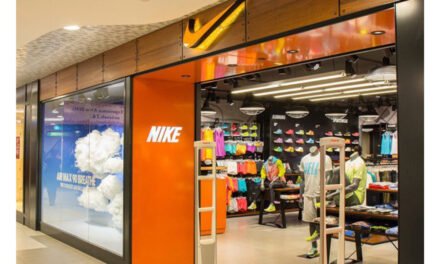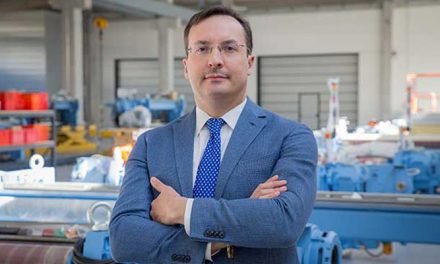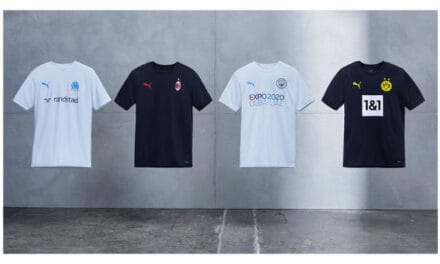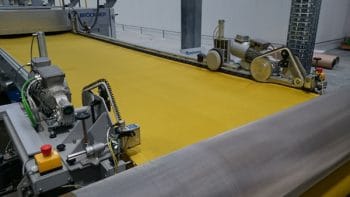 Tintex and Brückner have developed new process technology for coating bi-elastic knitted fabric which, according to the companies, ‘opens new markets and new possibilities.’
Tintex and Brückner have developed new process technology for coating bi-elastic knitted fabric which, according to the companies, ‘opens new markets and new possibilities.’
Tintex is located in Villa Nova, not far from the Spanish border in northern Portugal. The company was founded in 1998 in the region of Porto. The product range includes functional tricot fabrics for well-known fashion, sports and lingerie brands. Tintex is convinced that fashion can ‘truly make a difference in tackling climate change’. That is why its engineers are constantly developing new strategies and environmentally friendly concepts throughout the whole production process. The technologists’ expertise covers the entire textile supply chain, including dyeing and finishing techniques as well as coatings.
No Sustainability without Innovation’: True to this motto, Tintex says it is constantly researching fabric innovations to develop and produce intelligent, functional and high-performance textiles. And it is this mindset that led Tintex to cooperate with the German textile machinery manufacturer Brückner. Its product range includes machines and complete lines for the coating and finishing of textiles, technical textiles, nonwovens and floor coverings. The family-run company was founded in 1949 and is today managed in the second generation by Regina Brückner and her husband Axel Pieper.
Tintex’s vision was to be able to achieve ‘completely new effects’ on bi-elastic knitwear and to produce fabrics that did not exist before. This was followed by numerous tests at Brückner’s Technology Centre in Leonberg and on a Brückner line in a textile and process engineering institute near Stuttgart. From there, a new, ‘revolutionary’ line concept was developed together, which is said to have ‘unbeatable benefits’ especially with regard to temperature uniformity, the thermal treatment of synthetic fibre blends and other constructive issues. Even very difficult knitted fabric with high elastane content can now be directly coated or functionalised. Until now, such coatings were only possible in an indirect coating process, according to Brückner.
“All in all, we spent almost half a year on the joint development until the line concept was finalised,” explains Verena Ruckh, head of advertising and marketing, Brückner. “Tintex already knew the application process with screen, but not in combination with a stenter frame. This was their requirement and at the same time the challenge for us: the concept had to work for a wide variety of knitted fabrics, whether cotton, synthetics, or even fabrics with a high elastane content.”
“In the beginning, an additional, free-standing knife-over-cylinder coating unit was still under discussion, but this was then quickly dismissed, due to the long fabric path which is a no-go for knitted fabric,” she continues. “In the end, Tintex even partially aligned its product range with the new line concept, because completely new ideas and possibilities suddenly emerged during the development phase.
Design Parameters: The heart of the new line is the Power-Frame stenter frame dryer. The inlet and outlet components are specially designed for sensitive fabric and ensure a tensionless fabric run. A special, newly developed coating unit is integrated in the infeed stand of the stenter frame. Due to its variable design, two different application processes are possible on the same line. In the so-called screen coating process, water-based pastes and stable or unstable foams are applied onto the fabric with high precision by means of a driven, cylindrical screen and a squeegee system integrated in the screen, Brückner explains.
For paste coating, the machine parameters can be adjusted in such a way that a single-side coating is possible even on light knitwear made of cotton or viscose, provided the paste is of a suitable viscosity.
For the stable foam coating, the coating medium is mixed to foam with an exact foam/litre weight of 150- 300 g/l. With an integrated feed pump, this foam can be precisely dosed and applied to the textile through the screen. Also, in the case of unstable foam coating, the coating medium is foamed up with a mixer and applied to the textile in exact doses. Here the foam/litre weight is 30-100 g/l, the company continues.
As the unstable foam collapses shortly after leaving the screen, a single-side functionalisation with a very low pick-up of less than 10-20% can be achieved. This is said to be a minimum application with the corresponding benefits, eg considerable energy and thus cost savings in the subsequent drying process.
If the user wants to coat more stable fabric or apply higher coating weights, the unit can be quickly and easily converted from screen coating to a knife-over-cylinder system. The counter pressure roller is then used as coating cylinder.
A laminating/embossing calender integrated in the outfeed of the stenter allows various effects to be achieved on the fabric, eg a leather grain. If the applied stable foam coating has a certain layer thickness, this effect can be achieved after the drying passage in the laminating calender by means of a fed release paper or an appropriate embossing roller. Even with sensitive, directly coated knitted fabric, this calender can be used to apply a film, a membrane or a second textile web onto the fabric. For this purpose, the calender is additionally equipped with an electric short-wave infrared dryer.
For simple heat-setting processes a special roller has been developed which can be inserted into the coating unit instead of the screen and thus acts as the upper infeed roller. Even very tension-sensitive knitwear can be run with an overfeed of up to 60% before heat-setting, adds Brückner.
This new multifunctional line can therefore be used for heat-setting, drying and coating processes. It can be used to manufacture products comparable to those previously produced with indirect coating, but without having to rely on cost-intensive release paper. At Tintex in Portugal, production on this line has already been running for some time and research into completely new types of textiles is continuing. And, as for the markets that the resulting coated knitwear products target, Ruckh says that they are ‘very diverse’ but that Tintex produces mainly for the fashion industry as well as sporting goods manufacturers.
Discussing the strengths that the two partners bring to this new line concept, Ruckh says: “For such a project that Brückner and Tintex have realised together, a lot of intensive cooperation is necessary. Both sides have learned from each other and good friendships and a close bond between both companies have developed. A prerequisite for the successful completion of such a project is that both parties are willing to take a bit of risk and be open to new ideas. We are very excited to see what further developments the future will bring for both of us.”


